One night, my friends Jeff and Sharon showed up at the house with a large item wrapped in a heavy-gauge trash bag, a highly entertained gleam in their eyes. They walked into the kitchen and thunked it on the counter and continued to grin at me, silently challenging me to open their strange parcel. I slowly peeled back the blanket of thick plastic and revealed the skinned but otherwise very recognizable hind leg of an animal – in fact there was still a bit of fur attached here and there. “It’s deer!” they exclaimed with obvious delight.
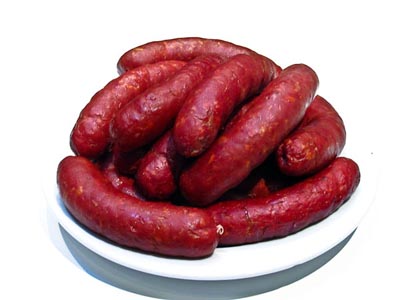
Turns out a coworker of Sharon’s is a deer hunter and after hearing that I made sausage and cured meat and that sort of thing, he kindly offered to send some deer meat to me. But it had been months since I’d heard that that might happen, and honestly, I had kind of forgotten about it. With vague warning, he brought it into work one day to give to Sharon and having nowhere to store a deer’s leg, Sharon and her husband Jeff brought it to me.
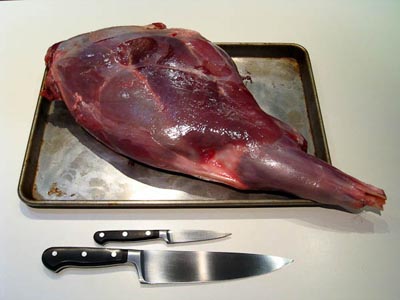
As it happens, the leg was frozen solid and much too large to fit in my freezer. I wedged it onto a half-sheet pan and did my best to wrap it in such a way that it would stay protected and not drip all over the refrigerator shelf as it thawed. Four days later, it seemed thawed enough to cut up, and during that four days, I hatched a plan for the meat and gathered ingredients. It was a good plan, but first I would need to get the meat off the bones.
Here’s where I confess that I’m an absolutely lousy butcher. For whatever reason, the whole time I was growing up around hunters and farmers, I never troubled myself to watch anyone take apart any creature larger than a catfish or chicken. After looking around on the ‘net for decent venison breakdown procedures, I decide that since I wouldn’t be prepping the deer in any way that pretty cuts would be important (no roasts or steaks in this batch), I would just do what I could to get meat and bone and sinews properly separated.
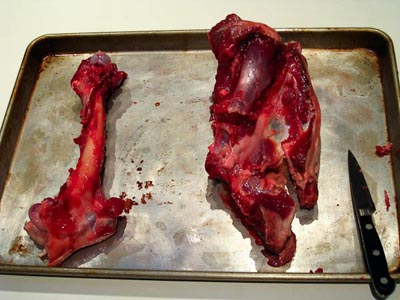
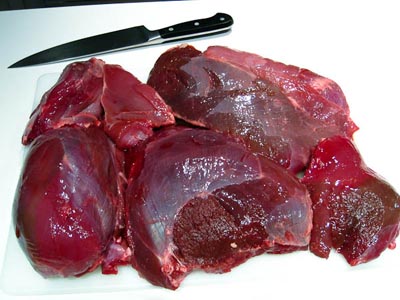
The first thing to be aware of is that deer is not fatty. The second thing to be aware of is that it is very sinewy. My approach to breaking down my deer leg was to cut delicately along the seams between muscles and carefully peel it away from the bone with the tip of my knife. Here’s an interesting aside. I honed and set out an 8" chef’s knife and a 3 ½" paring knife. Can you guess which knife I exclusively used when taking apart the deer leg? Surprisingly, at least for the way I took the leg apart, the paring knife was the only one I used.
I immediately packaged up the venison bones and chucked them in the freezer for use in stock-making later. I initially set aside the shank thinking I’d braise it, but it only weighed a pound (meaning there’d be considerably less than a pound of meat on the bone), so I opted to salvage what little meat I could from it and save the long slow braising for when I had more shanks at my disposal. Outside of that, I had around eight and a half pounds of meat to work with when all was said and done.
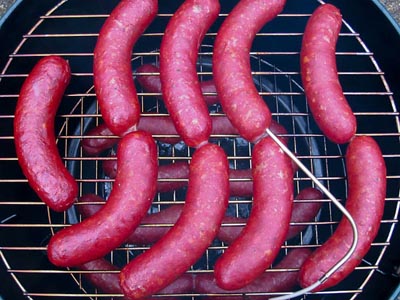
By far and away, the best thing I made with that deer meat was the Chef Milo’s Country Venison Sausage recipe from my old standby, Charcuterie: The Craft of Salting, Smoking, and Curing
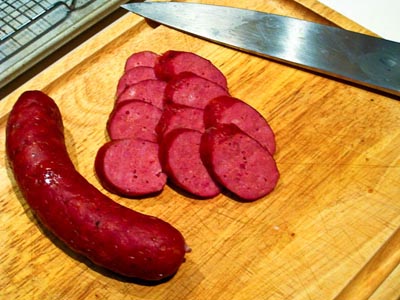
With a portion of it, I tried to make a spicy Texas chili. I leaned on a friend of mine for his championship chili recipe, and he happily obliged. The chili was delicious, but probably too heavily spiced to really get much of a venison flavor out of it. Were I to try venison chili again, I’d likely shoot for something less aggressively flavored.
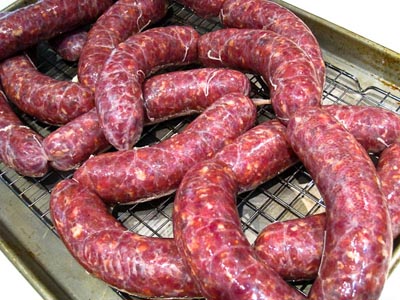
And with the final portion of it, I tried a fresh deer sausage flavored with sage and dried porcini mushroom, recipe courtesy of Hank Shaw of Hunter Angler Gardener Cook fame. The seasonings he called for in his recipe sounded like they would have been perfect for the woodsy flavor of the venison, and I was very excited to try the recipe, but things didn’t go as planned.
I have been told several times that if you make sausages and cured meats with any regularity, especially if you like to experiment, you’re eventually going to screw something up. Well, this time I definitely screwed up.
The flavor was indeed wonderful, but the texture was … not right. Despite supplementary back fat, the sausage was dry and tough. On closer examination, it looked as though the fat had cooked out of the meat and pooled up between the sausage and its casing. I understand this to be a symptom of not having gotten a good bind on the sausage.
After the sausage is ground, it is mixed for a short time with supplemental liquid to allow the separate tiny chunks of meat and fat to sort of combine into a nice sticky whole – not homogenized, just, well, bound together. I remember mixing it and mixing it and feeling like the meat and fat never integrated properly. I’m guessing my recourse should have been adding a bit more liquid to the mix. Instead, like the fool I sometimes am, I shrugged at the strangeness of it and cased it as it was. And consequently, I’m considering throwing out several pounds of lovely porcini-scented venison sausage.
My deer leg experiment was an interesting one. It again drives home the fact that I lack butchering skill, and I’ve since been on the lookout for good ways to acquire those skills. I like the flavor of deer meat, and it’s something I’ve been missing apparently. There were several hunters in our family growing up, so it was rare that there wasn’t deer meat in our freezer. Now, like so many have pointed out, our meat largely comes in little cellophane-wrapped packages and bear little or no evidence that they were ever part of a living, breathing creature.